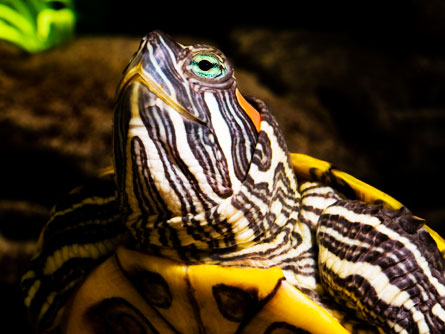Foreign turtles may do so well at invading Europe in part because they get the drop on tadpoles more readily than their native counterparts.

Several kinds of Spanish tadpoles were less likely to grow wary at the presence of newly arrived turtle species compared with their longtime native predators, according to a study by Nuria Polo-Cavia of the Universidad Autónoma de Madrid and her colleagues.
The invaders could thus be gaining an advantage over natives in competing for food, Polo-Cavia and her colleagues suggest in a paper to appear in Animal Behaviour.
The Iberian Peninsula has seen disturbing declines in two natives, the European pond turtle and the Spanish terrapin. Among their troubles is competition from exotic turtles that have escaped from the pet trade, including the red-eared slider and the false map turtle.
All these turtles hunt tadpoles to some degree. And other research has shown that even quite inexperienced tadpoles can be canny when it comes to things that might eat them.
The researchers tested the tadpoles of Iberian green frogs and western spadefoot toads, collecting both from ponds without turtles of any kind. Researchers then released the tadpoles in containers dosed with water pulled from a tank where a native turtle had swum.
Even though these tadpoles had never encountered the European pond turtle, they seemed to detect danger. The tadpoles stopped moving around as much, reducing their activity by about half of what it was when tested in water spiked with the contents of a tank containing a harmless fish.
Iberian green frog tadpoles proved quite a cautious species, also lessening their motion when they scented a second, less carnivorous native, the Spanish terrapin. Tadpoles of common tree frogs likewise stopped darting around as much in water scented with either native turtle.
Yet these savvy tadpoles just didn’t get it when researchers repeated the tests with water from tanks that held either red-eared sliders or false map turtles. Bathed in water scented with these invasive menaces, the tadpoles still darted around as much as they had in eau de fish.
These invaders aren’t that closely related to native European species, so whatever cues the tadpoles use to detect their local menaces don’t seem to apply to the newcomers, the researchers concluded.
Tying the tadpole recklessness to a possible edge in food competition “is an interesting wrinkle,” says Joseph Kiesecker of The Nature Conservancy’s office in Fort Collins, Colo., who also has studied nervous tadpoles. Recognizing an invasive species is a lot easier than figuring out how it’s succeeding, he says, so he welcomes work exploring the mechanics behind invasions.
“Globally we have an invasive species crisis that doesn’t get a lot of attention,” Kiesecker says.
His own work raises a glimmer of hope for the European tadpoles. When he and his colleagues studied invasive bullfrogs in the American West, some native tadpoles showed signs of updating their sense of danger.





